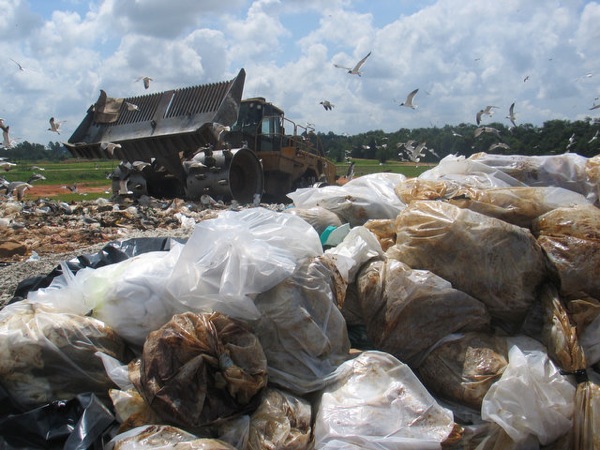that can't happen here..
Everything is just fine and dandy...eat the fish..swim in the water...keep drilling.
Cor-what?
oh,,and by the way..BP will NOT be paying out all those "claims" by people who were effected by this,
since it was not really so bad....

Magnolia landfill during initial cleanup, courtesy of Press-Register, Connie Baggett
http://www.mnn.com/green-tech/research-innovations/blogs/death-gyre-in-the-gulf<snip>
According to the latest count of the U.S. Fish and Wildlife Service's Daily Collection Report (PDF), only about 4,100 birds, 670 turtles, 70 sea mammals, and 1 snake have died in the Gulf since April 20 (assuming 50 percent mortality of live animals).
It's an astonishingly low number, considering that one of the largest pods of sperm whales in the U.S. resided just miles from the site of the BP Macondo well (aka Deepwater Horizon), a region home to one of the most abundant and biodiverse marine ecosystems in the world.
Compare those small numbers with the Exxon Valdez spill ... Best estimates put the toll of the far smaller oil spill in Alaska at more than 200,000 birds (including hundreds of eagles), more than 3,000 sea mammals, more than 20 whales, and billions of fish eggs. The accident permanently wiped out the herring population of this Alaskan Gulf region. And that was an accident 1/10th the size of the Deepwater Horizon.

<snip>
One would be forgiven then for assuming there should be a far greater body count than what is currently being reported by the Fish and Wildlife Service, the same government office that famously blocked Anderson Cooper from peering past the 10' high barricades that had been put up to enclose a "bird receiving" area. According to the math, the count should be in the hundreds of thousands of dead birds, tens of thousands of sea mammals, and millions upon millions of fish and shellfish. So where were all the dead bodies? We should be seeing something like the mass dolphin kill off the coast of Zanzibar (below) that resulted from a much smaller offshore oil leak.

<snip>
The following three photographs (taken in the first week of June and published here for the first time) document the processing area just prior to commencing operations.
A large-scale construction project, which included creating a visual barricade on a 200' long pier, several large cranes adjacent to lined pools at least 50' in length, and a series of large tents alongside a fleet of trucks, gives further credence to the theory that BP, with the help of the U.S. government, was processing some form of waste that they did not want the public to know about:


A team of journalists, including Jerry Cope of the Huffington Post and Charles Hambleton, co-producer of the Academy award-winning documentary "The Cove", went down to the region to investigate. They had some interesting findings -
http://www.huffingtonpost.com/jerry-cope/the-crime-of-the-century_b_662971.html - to report and got some great interviews with locals on the mystery of the disappearing dead animals.
You might be wondering about motive. Sure BP probably wanted to keep the full, gruesome reality of their toxic nightmare out of the press as much as possible. But was that enough of a motive to warrant such a massive and expensive operation? Probably not. A greater incentive may have been the fines the company would have incurred if the correct number of dead carcasses had been verifiable. At $50,000 a pop -
http://www.csmonitor.com/USA/2010/0625/Gulf-oil-spill-s-wildlife-toll-sharks-near-shore-turtles-incinerated - , hundreds of thousands of dead animals could spell B-A-N-K-R-U-P-T-C-Y for BP, and that's something that no one, including the U.S.
government, would have wanted to happen.
It is very, very sad how many folks will buy that wheelbarrow full of crapola.
:mad: :wtf: